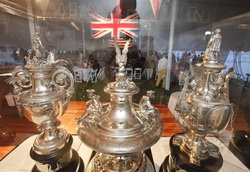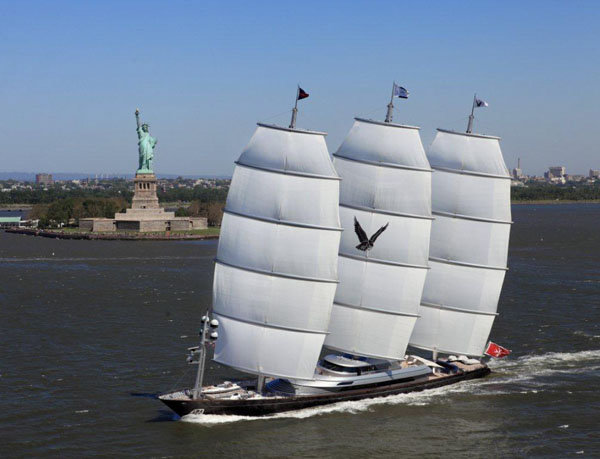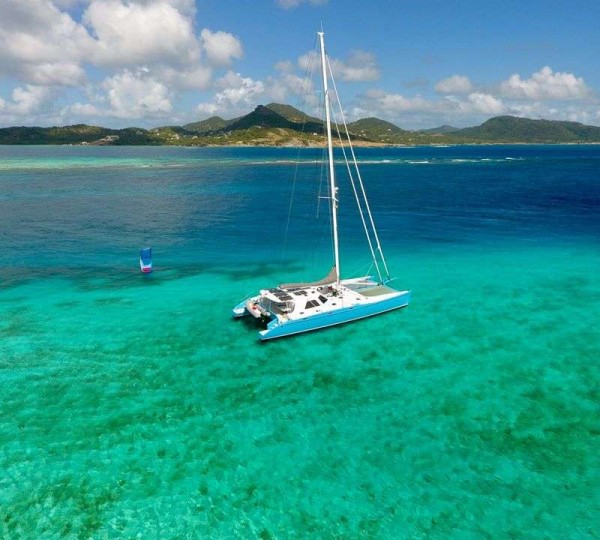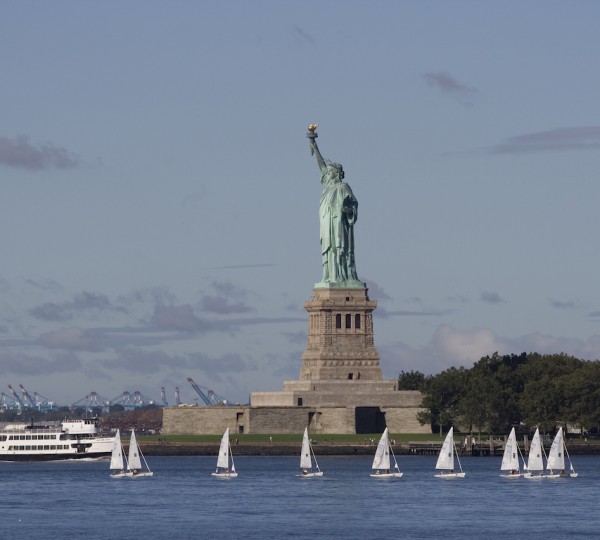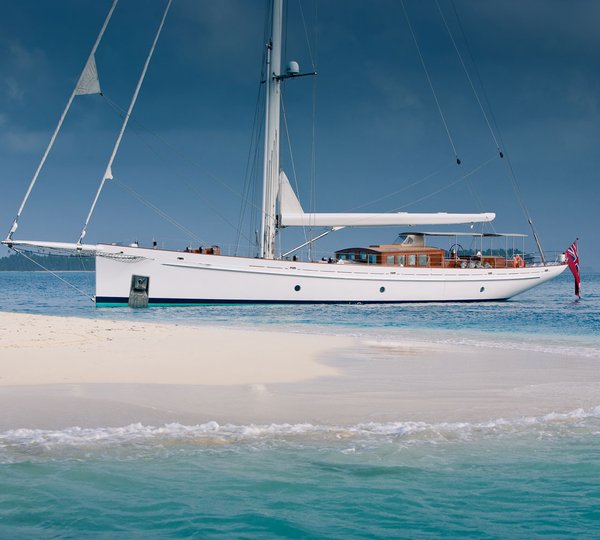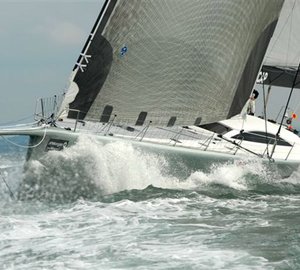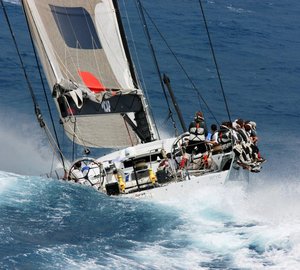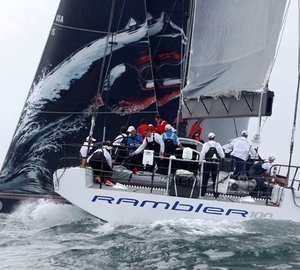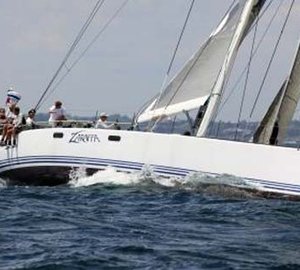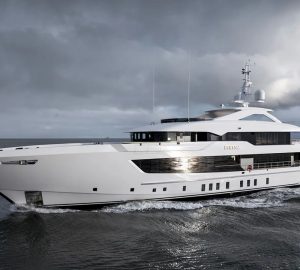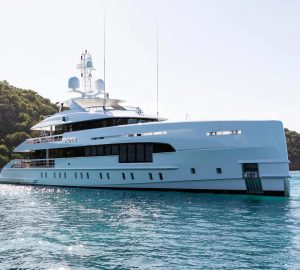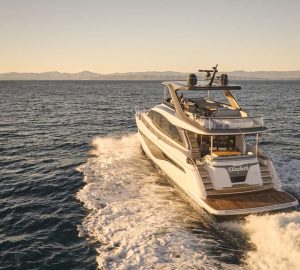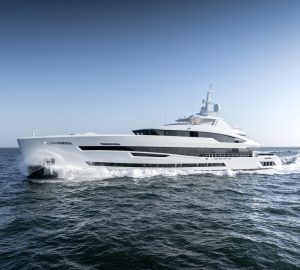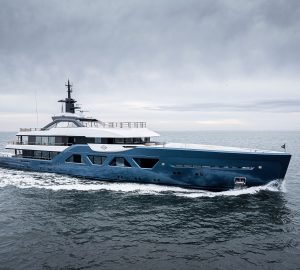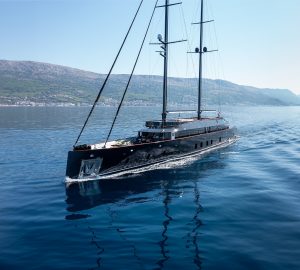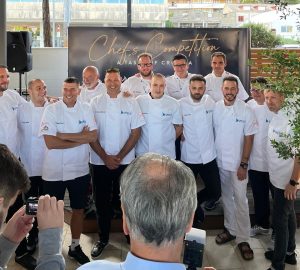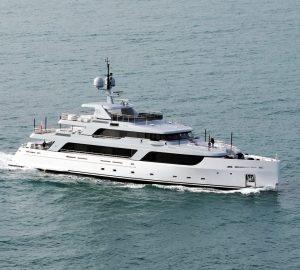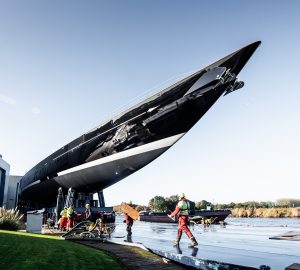Tomorrow, at Newport, R.I. USA cannon fire from the iconic Castle Hill Lighthouse will signal the beginning of a historic ocean adventure when six yachts are sent off on the Transatlantic Race 2011. The warning signal for the first of the three staggered starts is at 1:50 p.m. on Saturday, June 26, and will be replicated on Wednesday, June 29, and Sunday, July 3, with the ideal result that the vessels – ranging in size from 40’ to 289’ – will finish off The Lizard on the South Coast of England in close proximity to one another.
The New York Yacht Club has hosted 11 of the 28 North Atlantic races that have been held since 1866, and few have had more entries than the 2011 edition. Modern ocean racing began with the first transatlantic race, won by James Gordon Bennett Jr. Three NYYC members entered that inaugural race, each wagering $30,000 in a winner-takes-all dash across the ocean in bitter winter conditions. Bennett’s Henrietta finished the race on Christmas day to win the equivalent of more than $2 million dollars in today’s money.
More importantly, the inaugural event created a new, exciting and captivating sport, which embraces the values of devotion to duty, technological development and unquestionable sportsmanship. Those values still remain to this day and over the next few weeks triumphant yachts and characters of the sport will join the honor roll for this highly prestigious and historic sporting event.
Hosting the majority of the 26 yachts — representing ten different nations from the four corners of the globe — entered in the TR2011, Newport Shipyard is a spectacular sight and a hive of activity as crews prepare themselves and their yachts. The 289’ Perini Navi Maltese Falcon is nearly three times the length of any other entry and her revolutionary three masted rig dominates the skyline. The numerous and fantastic maritime creations waiting their opportunity to depart on the race span seven generations and include classic and modern examples of ocean going yachts. From high performance canting keel Maxis to pocket rocket Class 40s, as well as traditional spirit of tradition yachts from days gone by, it is a truly rare sight to see such a fleet gathered together in one place.
Last night, the sailors put aside their dockside labours to attend a very special occasion. Following the Captain’s Meeting and a reception hosted by Thomson Reuters, honored guests and TR 2011 competitors enjoyed a dazzling opening dinner at Harbor Court, the magnificent waterside clubhouse of the New York Yacht Club in Newport, Rhode Island.
NYYC Commodore Robert C. Towse, Jr. was delighted to address the ensemble, with a special mention for representatives of the organising yacht clubs in attendance. “We are privileged tonight to welcome Royal Yacht Squadron Vice Commodore David Aisher, Royal Ocean Racing Club Commodore Andrew McIrvine and Storm Trysail Commodore Eric Kreuter. T his race is the result of the dedication and hard work of the steering committee, which is composed of members of all four clubs, co-chaired by George David and Stephen Frank and I would like to thank them all.”
“This is a big ocean race, 26 yachts racing just shy of 3000 miles,” continued Towse. “The North Atlantic will be wet and cold in June just has it has been for the 482 boats that have raced before, crewed by 6750 sailors in the history of the race and, as ever, this race will bring together generations to build character and to reaffirm values that they believe are true. The cold climate of the North Atlantic may test that purpose, but at The Lizard finish those boats and their crews will have earned one of the hardest of sailing distinctions. We wish you all the best of luck.”
During dinner NYYC Trustee Clay Deutsch gave a passionate review of the race and colorful description of the competitors on behalf of the organising committee. Every team was given a rousing reception, each in turn rising to the toast. Deutsch summed up the wide-ranging diversity of the entries: competitors include aspiring young sailors, veteran Corinthian amateurs and some of the world’s greatest professionals of the offshore discipline.
The quantum leap in maritime communications since the first race in 1866 will make the Transatlantic Race 2011 riveting viewing for spectators the world over. All of the competing yachts are not only fitted with hi-tech Yellowbrick tracking devices, but also have the capability of sending back stories of life on board via email and phone via the latest in satellite communication technology.
Sponsors of the TR 2011 are Rolex, Thomson Reuters, Newport Shipyard, Perini Navi, and Peters & May.
More about the Transatlantic Race 2011
The Transatlantic Race 2011 charts a 2,975 nautical mile course from Newport, R.I., to Lizard Point, South Cornwall, England. Pre-start activities will take place at the New York Yacht Club’s Harbour Court clubhouse in Newport, while awards will be presented at the Royal Yacht Squadron’s Cowes Castle clubhouse on the Isle of Wight. Three separate starts – June 26, June 29 and July 3 – will feature 30 boats ranging from 40 to 289 feet in length. In addition to winners in seven classes (IRC Class 1 Racer, IRC Class 2 Racer, IRC Class 3 Racer/Cruiser, IRC Class 4 Racer/Cruiser, Classic, Class 40, and Open), whichever yacht finishes the course with the fastest elapsed time will set the benchmark for a new racing record from Newport to Lizard Point, to be ratified by the World Speed Sailing Council. Rolex watches will be awarded to the record holder and the overall winner (on corrected time) under IRC.
The Transatlantic Race 2011 is also the centerpiece of the Atlantic Ocean Racing Series (AORS), which includes the Pineapple Cup – Montego Bay Race, RORC Caribbean 600, the Annapolis to Newport Race, Rolex Fastnet Race, Biscay Race and the Rolex Middle Sea Race. Of the seven races in the AORS, three races, including the TR 2011 must be completed to qualify for a series victory. Each race is weighted equally in overall series scoring with the exception of TR 2011, which is weighted 1.5 times. All entered yachts are scored using their two best finishes in addition to the TR 2011. Awards for the AORS will be presented in November, 2011, at the New York Yacht Club’s Annual Awards Dinner in Manhattan.
The extremes of crossing the Atlantic Ocean will be experienced very differently by crews on the longest and shortest yachts competing in the upcoming Transatlantic Race 2011 (TR 2011). This adventure challenge, which aims to add 2,975 nautical miles to its participants’ log books, is co-organized by the Royal Yacht Squadron, New York Yacht Club, Royal Ocean Racing Club and Storm Trysail Club. The TR 2011 starts off Castle Hill in Newport, R.I. (on Sunday, June 26; Wednesday, June 29; and Sunday, July 3) and expects to greet its first finisher off Lizard Point in South Cornwall (UK) sometime in mid-July, depending on many things, not the least of which are the lengths of the boats making the crossing.
On the one hand there is the Perini Navi designed Maltese Falcon, at 289 feet, one of the largest privately-owned sailboats in the world. On the other there are two Class 40s, which at 40 feet are specially designed for short-handed offshore and coastal racing. These extremes are punctuated by the fact that Maltese Falcon looks every bit the world cruiser, with stem-to-stern luxury incorporated into its design, while the Class 40s seem relatively stark–even like dinghies–in comparison. But each team at either end of the spectrum has its reasons for undertaking the TR2011 challenge, and each team intends to succeed, if not win.
“The experience of sailing on Maltese Falcon is incredible,” said the boat’s longtime captain Chris Gartner (Antibes, France). “Since there is no other boat in the world like it, it’s really a one-off. Every time I go sailing on her and we get her wound up, I’m almost in awe just looking up at the rigs.”
The yacht’s three self-standing and rotating carbon fiber masts, which carry 15 sails with a combined sail area the size of three and a half tennis courts (25,833 square feet), are of such an imposing height–190 feet, in fact—that recent visitors to Newport have experienced “the Falcon” at almost eye level as they’ve crossed the 206’ high Claiborne Pell Bridge, which serves as the gateway to Narragansett Bay and its adjacent Newport Harbor. With its long waterline and such magnificent sail power, Gartner thinks Maltese Falcon has a good chance to win, but “it’s hit or miss with the weather,” he says. “If we get good pressure coming up behind us and we stay with it, we could finish this race nicely.”
Gartner added that logging 500-mile days would make Maltese Falcon’s voyage about six days, but longer is more likely. “If we do it in less than 12, I would be very happy,” he said, noting that the World Sailing Speed Record Council will ratify a new Newport to Lizard Point race record based on the fastest yacht’s elapsed time.
And while Maltese Falcon will be dry and comfortable, and sailing with a large crew, the two Class 40s will be roughing it with minimum comfort, eating freeze-dried food and sailing with anywhere from two to six onboard.
Team Concise was set up four years ago by owner Tony Lawson (Haslemere, UK) specifically to encourage and develop young British offshore sailors and will be entered in the TR 2011’s challenge for the Youth Trophy. His team of six (the maximum for the Class 40) will be skippered by Ned Collier-Wakefield (Oxford, UK).
“We sail six-up when allowed simply to give the largest number of young sailors a chance to do these big races,” said Lawson, explaining that the Class 40, built to a box rule and considered the world’s fastest growing offshore class, is designed for short-handed sailing, but several of the events on the class’s calendar are fully crewed. “So far, Concise teams have won the Class 40 World Championships, broken the Sevenstar Round Britain and Ireland Race record for a 40-foot boat, and twice set a new Class 40 course record at the RORC Caribbean 600.”
“Just me and one other guy (co-skipper Rob Windsor) – less people to get along with,” joked Hennessey, adding seriously, “We’ll be on deck at the same time for sail changes, but otherwise it’s typically two hours on, two hours off.”
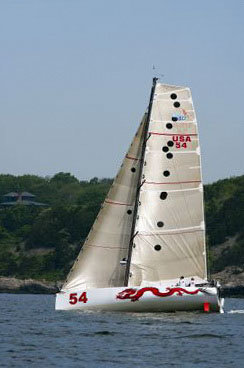
dragonnycSailing double-handed in the Class 40 division will be Michael Hennessey (Mystic, Conn.) on Dragon
Hennessey was encouraged that in April of this year a Class 40, skippered by Eric Defert, sailed from Ambrose Light (off Sandy Hook, NJ) to Lizard Point (a distance of 2880 miles) in 11 days and 11 hours.
“That sort of sets the benchmark at the bottom end of the range; however, Eric was able to pick his weather system,” said Hennessey. “I would be thrilled with anything less than 12 days. I’m realistically expecting 13 to 14 days, and upper end who knows? It’s up to the weather gods.” As for plotting Dragon’s course relative to the rest of the fleet scheduled for the June 29 start (that includes Maltese Falcon), Hennessey said, “We’ll be most conscious of where Concise 2 is, as she is our pace horse, if you will. For the rest of the fleet, I think it really depends on how the IRC (handicap rating) spread looks.”
There are 26 entries sailing in the TR 2011, with the U.S. fielding 10 teams, Germany six, the UK four, and South Africa, St. Barth’s, Italy, Monaco, China and Lithuania one each. The yachts will be tracked with Yellowbrick Trackers, self contained units that transmit the position of each boat at regular intervals using GPS and Iridium (a global satellite phone network). Synchronized position reports will be available to the public by using the Race Player Application at the www.transatlanticrace.org website, where regular race reports will appear and Facebook and Twitter accounts are linked. As well, throughout their journeys, many of the boats will be posting blogs and sending back photos and videos to the race website, so race fans can be further assured of an up-close and personal experience with the teams and the racing action.



